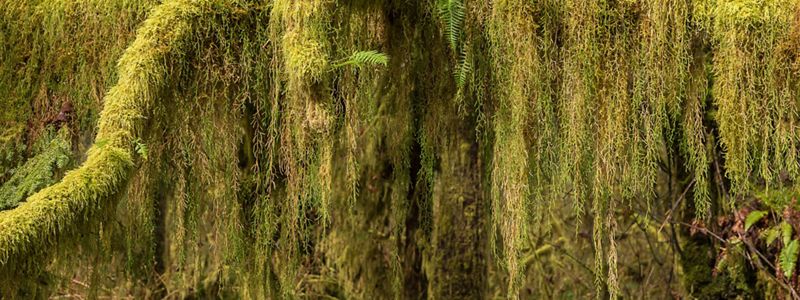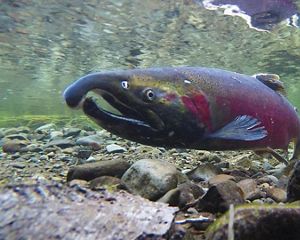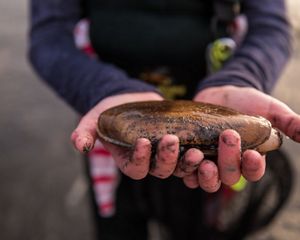Port Susan Bay Preserve: Where Have All the Chinook Gone?
By Grace Lee Kang

Part 1
While out in the waters of the Stillaguamish Estuary, the marsh where the Stillaguamish River meets Port Susan Bay, Nature Conservancy Aquatic Ecologist Dr. Emily Howe and Skagit River System Cooperative (SRSC) Lead Field Biologist Brian Henrichs witnessed something they had never seen before. And one urgent question was running through their minds—where have all the Chinook gone?
Port Susan Bay Fieldwork

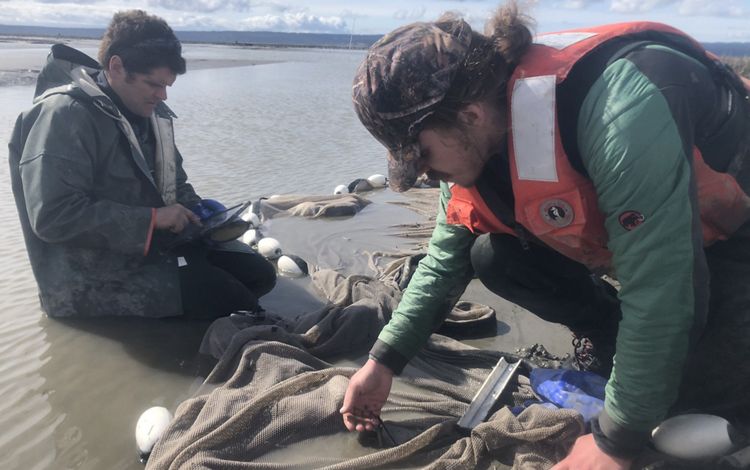
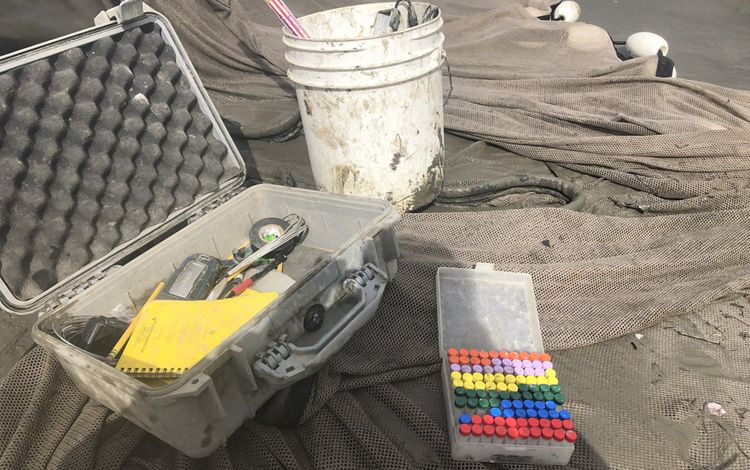
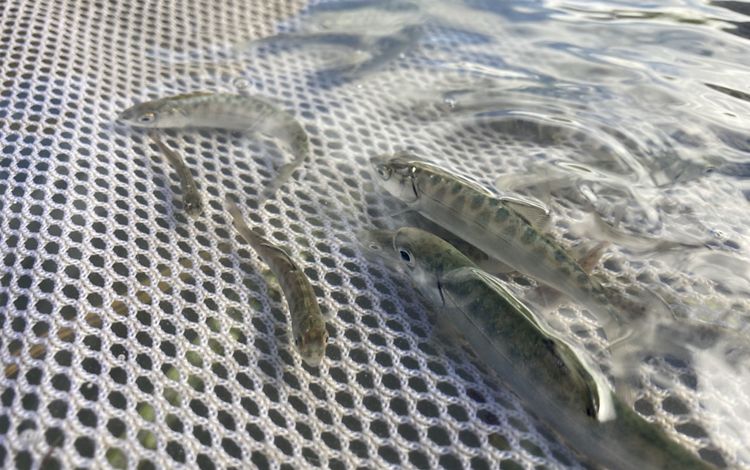

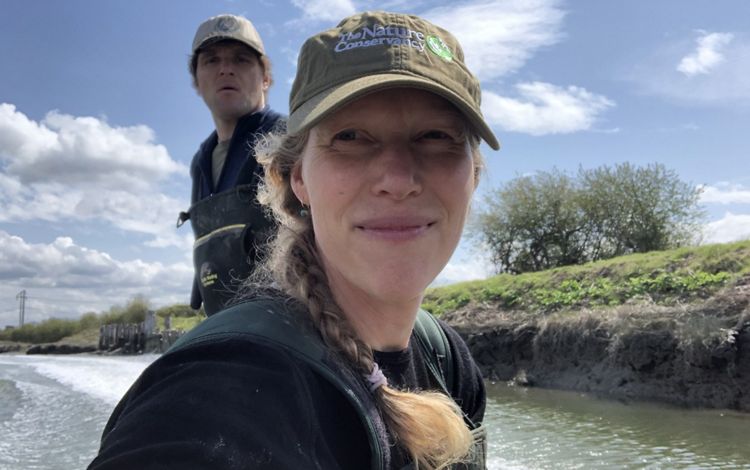

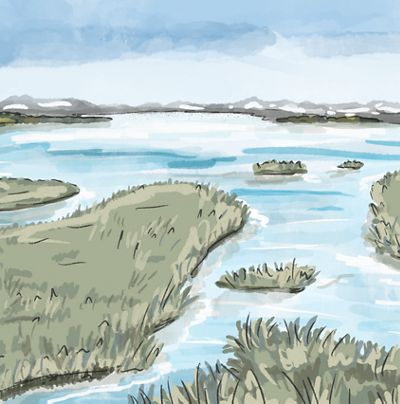
In conducting fish sampling across the estuary for a collaborative research and monitoring effort in the spring of 2022, it became clear there was a precipitous drop off in the number of juvenile Chinook salmon compared to previous years. “We go out twice a month to monitor a suite of 25 sites across the estuary and Port Susan Bay. We set and pull up the net from the same set of sites, week after week from February through August. But this year, the Chinook weren't showing up. In fact, hardly anything was showing up,” Howe recalled.
In Puget Sound, April is typically a time of peak outmigration from the rivers into the estuary for juvenile Chinook. Last year’s numbers were staggering. The research team was only able to catch a fraction of their allotted research quota, a planned total of 80 fish to be collected from April through June. With such drastically reduced catches, Dr. Howe and her research partners first wondered, “Is there something about the way we’re setting the nets? Are we just not successful at catching them this year?” Eventually, they began to ask a different question: “Is there a much larger story here?”
Piecing Together the Larger Story with Local Partners
Searching for answers, Dr. Howe and her collaborators at the Skagit River System Cooperative, which provides natural resource management support for the Sauk-Suiattle Indian Tribe and the Swinomish Indian Tribal Community, reached out to Tribal, state and county managers on the Stillaguamish and other rivers to confirm if they were seeing similar numbers.
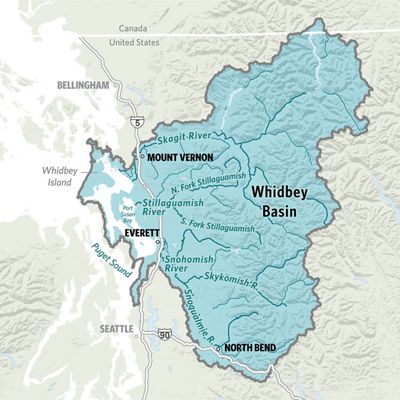
The story was the same across the Whidbey Basin, which includes the Skagit, Stillaguamish and Snohomish Rivers: the juvenile Chinook numbers were much lower and were later to arrive. On the Stillaguamish River, outmigration—when salmon leave their home stream to mature in the ocean—was less than 5% of normal April numbers. The numbers picked up in May (a delayed peak is normal for cold, rainy springs) but were still low. On a given day during peak outmigration, there should be hundreds of fish going through upriver smolt traps, the tools used to count fish moving downstream on their way to the estuary. But there were only a few dozen moving through the traps each day this past spring. Final outmigration estimates are still forthcoming for the Whidbey Basin rivers but seem to be hovering around 30% of normal.
There wasn’t anything wrong with the way Howe and Henrichs were setting the nets, after all. The fish just weren’t there this year. “No matter where we were in the estuary, the channels were quite empty of Chinook,” said Howe. “It was a moment where you feel what you know, you feel it in your gut. And it’s a really different way of knowing a system and a problem.”
While we don’t have a definitive answer as to why there were so few Chinook outmigrating this past season, signs point to last winter’s unprecedented flooding and a warming climate that increasingly supports large storm events. In November 2021, a series of back-to-back atmospheric rivers slammed into the region with record rainfall, inundating floodplain communities and catastrophically crumbling infrastructure. The flood events were also hard on this generation of salmon; it’s likely most of the Chinook eggs incubating beneath streambed gravels were simply washed away.
Salmon populations have been declining for decades from a multitude of factors including habitat loss, toxic stormwater runoff, dams and warming waters. James Schroeder, Washington State conservation director for The Nature Conservancy, ties most of these threats to salmon back to one principal culprit: climate change. “Climate change encompasses many types of threats and affects salmon across their entire life cycle, even in remote areas,” Schroeder says. “Young fish need cold water—rivers are warmer, oceans are warmer, current patterns and upwelling are changing, more runoff causes more urban pollution.” And, Schroeder points out, because of salmon’s expansive migration and range, their recovery faces a more complex challenge than that of many species. “With other endangered species, you can circle a spot on the map to target for restoration,” he says. “But salmon are different. You can’t just fix one area.”
Tribes Leading the Way

As co-managers and leaders in salmon recovery, Tribal Nations see and feel the impact of declining salmon throughout their communities. According to the 2020 State of Our Watersheds report, as the salmon disappear, Tribal cultures, communities and economies are threatened like never seen before. Some Tribes have even lost the most basic ceremonial and subsistence fisheries that are a foundation of Tribal life and culture.
Yet, there is a sense of hope when looking through the lens of long-term progress. Tulalip Tribes Director of Natural Resources Jason Gobin notes, "There have been strides made [compared to 30-40 years ago] with the science to better understand these life cycles and processes for salmon and river habitats. This understanding will help guide us as we continue to make the march up the hill to carry these salmon forward for future generations.”
It will take an ongoing commitment to preserving a vital resource for everyone. “It’s important work, which is why we do it the right way with the right approach; for instance, trying to deed-restrict the properties we purchase to protect them. When they’re set aside for fish and wildlife, for treaty rights, that benefits all of us—even those who aren’t in Tribal Nations,” says Jason Griffith, environmental manager for the Stillaguamish Tribe.
Part 2
Rebuilding an estuary, one of the most productive ecosystems on earth, takes dedication.
Estuaries, the marshy areas that exist between where the land meets the sea, provide productive feeding grounds as well as refuge from predators and are an important transition zone for young salmon as they physiologically acclimate from fresh to salt water. Estuarine marshes are critical habitat—without them, Chinook salmon in Puget Sound will not recover.
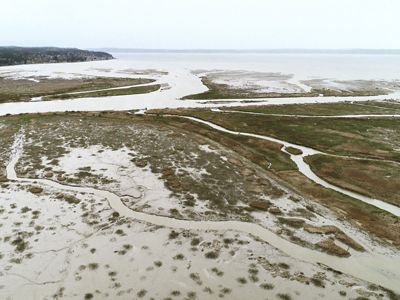
In order for salmon to adapt to climate change, we need to protect and restore the many habitats necessary to complete their life cycle. Last winter’s floods highlighted the vulnerability of upstream spawning habitat, areas where salmon lay their eggs, to climate change. Large flood events with swift water can scour the river bottom, leading to low survival rates. Estuaries are another climate-vulnerable salmon habitat.
In Puget Sound, there is an extreme deficit of functioning estuary habitat that is severely impacting not just salmon but a host of other wildlife and the human communities that rely on them. To put it into perspective: the Skagit, Snohomish and Stillaguamish Deltas draining into the Whidbey Basin account for ~70% of Puget Sound’s historic delta habitat, yet only 31% of that acreage remains. With climate change, these remnant marshes are further squeezed between rising sea levels and the land.
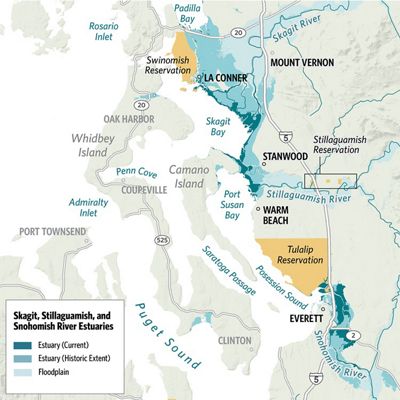
Alongside the work of local partners also working in the area, TNC has been working to address this issue directly through estuary restoration at the Port Susan Bay Preserve. In 2012, the first large-scale restoration phase removed 7,000 feet of dike that had separated the 150-acre marsh from the rest of Port Susan Bay since the 1950s. Ten years of ongoing restoration efforts, tides and data collection later, some key barriers still remain. For instance, the stalled development of small channels within the marsh and a lack of direct connection between the restoration site and the Stillaguamish River mean fish struggle to access most channels in order to feed and grow.
And yet Port Susan Bay Preserve is just one part of a wider network of restoration and land management projects across Puget Sound, often led by Tribal Nations. Collaborating with local partners has been a priority to open up new possibilities with even larger-scale restoration. Like with the Stillaguamish Tribe’s 248-acre parcel adjacent to Port Susan Bay Preserve—an exciting opportunity to see a restoration design implemented in synergy with TNC’s restoration efforts to date, which will further create opportunities for connectivity across the river, marshes and the bay.
As seen through other estuarine restoration projects along the west coast, as well as river restoration projects like those developed by the Skagit River System Cooperative, recovering diverse, functional and connected channel systems ultimately builds a stronger, more resilient landscape.
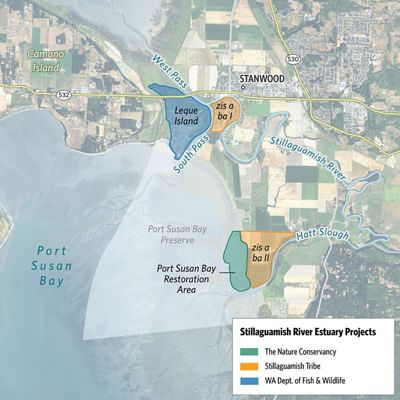
A Collaboration, Innovation and Learning Network Powered by Years of Partnership and Research
Together with local research partners, TNC has been contributing new data and learning to the research landscape over the past decade. The land and restoration projects serve as a key foundation, enabling research teams to formulate hypotheses and monitor ecosystem response.
By monitoring channel development and mapping out the length, width and depth of channels within the restoration zone, the Skagit River System Cooperative (SRSC) gained a better understanding of the rate of recovery. Researchers at Western Washington University measured sediment accretion rates to understand how well fresh water and sediment are distributed across the delta by the river, and therefore how well different areas of the delta’s marsh ecosystem are keeping up with sea-level rise. Since 2012, The Nature Conservancy (TNC) has also run annual vegetation and salinity monitoring crews across the Stillaguamish delta to develop a long-term dataset indicative of marsh resilience. And recently, TNC has teamed up with SRSC to monitor fish populations throughout the Stillaguamish delta, knitting together a suite of restoration projects to support delta-wide learning.
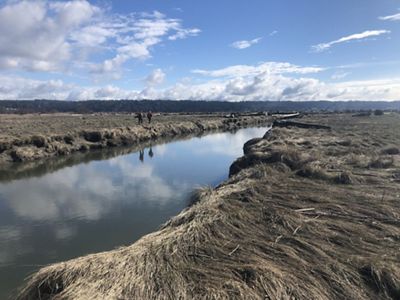
The more robust and comprehensive the data, the more we can uncover linkages between river hydrology, restoration design and ecosystem responses—including critical factors that indicate the long-term resilience of healthy marsh ecosystems, or the ability of the delta’s restoration projects to support salmon growth and survival.
With the thousands of hours of research and data collected over the past 10 years, these areas of study have driven the current adaptive management approach to restoration planning, where techniques and concepts are tested in an environment that’s continually shifting from climate change. And now we can use past data combined with current data and modeling to look forward to a brighter future—one where we might foster a healthier and more resilient habitat for Chinook salmon.
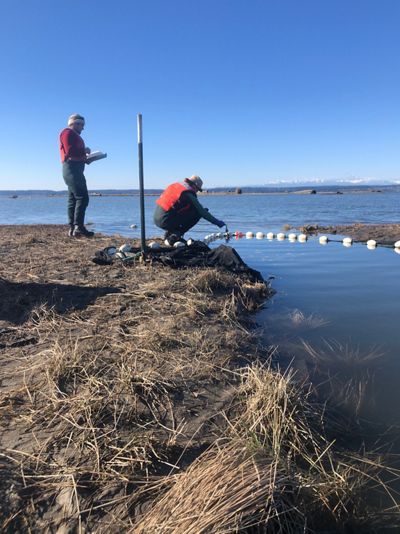
Looking ahead, the latest research continues to explore and test innovative ways of thinking. In collaboration with the Skagit River System Cooperative team, TNC scientists are considering an important question: how can a restoration project influence neighboring areas? Can increasing channel connectivity in a critical location enhance Chinook distribution across the entire estuary? Can certain channel connections influence habitat conditions enough to ultimately affect the growth potential and survival of young fish moving through the system? By better understanding the biology of the fish and how they interact with the environment, we can adapt restoration work to address the evolving impact of climate change with greater precision.
As part of a network of restoration and land management projects, each one is like a collaborative learning and innovation space with the ability to share knowledge from the other, and, in theory, recovery could cascade across the whole of the delta, beyond the borders of the preserve.
Advancing conservation is a large-scale, ongoing collaborative effort between TNC scientists and fellow partners. From preserve managers and project engineers to community members and Tribal scientists—throughout the restoration process, a focus on collective success to meet not just conservation outcomes but the goals of local communities, partners and ecosystems will drive success that lasts.
We Can’t Save Nature Without You
Sign up to receive monthly conservation news and updates from Washington. Get a preview of Washington's Nature News email.
